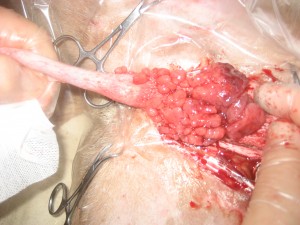
The Tasmanian devil, the world’s largest marsupial carnivore, is facing possible extinction in the wild due to a transmissible facial cancer known as Tasmanian devil facial tumour disease (DFTD) (Figure 1). DFTD is spread when living cancer cells are spread between animals by biting. In DFTD, the living cancer cell itself is the infectious agent of disease and it remains unclear why these cancer cells are not detected and rejected by the devil’s immune system. The distressing plight of the Tasmanian devil has drawn attention to the existence of transmissible cancers, parasitic cancers spread by the transfer of living cancer cells between hosts. However, it remains a surprisingly little-known fact that the only other transmissible cancer that bears any resemblance to DFTD is a dog cancer that is right under our noses here in Australia.
Canine transmissible venereal tumour (CTVT) is one of the world’s most remarkable cancers. It is a transmissible cancer that affects dogs worldwide. Usually spread during coitus, the disease is most prevalent in areas with large numbers of free-roaming sexually active dogs. The tumour affects both male and female animals, and appears to affect dogs of any breed. CTVT generally manifests itself in the appearance of tumours in and around the genital area, often at the base of the penis in males and in the vulva of females. Starting as small shiny pink/grey lesions, the tumours can progress to become very large and multi-lobulated (Figure 2). The tumour may aggressively invade surrounding tissues and become ulcerated and secondarily infected. However, a combination of surgical debulking and chemotherapy (using vincristine) is often curative.

Genetic studies have provided strong evidence that CTVT is in fact one living cancer cell line that has spread worldwide with dogs. Thus all CTVT tumours are derived from a single original tumour that arose once and has been transmitted through the dog population as a clone. The tumour itself bears closest genetic resemblance to wolves, suggesting that this tumour may have first arisen in a wolf before hitch-hiking its way into dogs through sexual contact. Genetic evidence suggests that the tumour may in fact be quite old, and that the original wolf that gave rise to the tumour may have even lived thousands of years ago. CTVT is by far the oldest known continuously growing cancer in the world.
Although the CTVT research literature stretches back more than one hundred years, we still understand surprisingly little about this disease and how it evades its host’s immune system. It is important to understand this disease not only because it is one of the most interesting veterinary cancers, but also because it may harbour clues which could help us to save the Tasmanian devil. Why, for instance, is CTVT so responsive to chemotherapy in contrast to DFTD which appears to be completely unresponsive?
My research is aimed at using modern genetic techniques to understand the origin and evolution of transmissible cancers. By comparing and contrasting DFTD and CTVT tumours collected from different locations and from different hosts, I hope to understand the genetic mutations that caused these cancers, and to use genetic variations between tumours to understand the spread and evolution of the tumours. I am currently collecting and analysing the genetic profiles of CTVT tumours from many different countries around the world. Ultimately, I hope that the work may help us to find ways to help the Tasmanian devil to combat DFTD.
CTVT is present in Australia, and appears to be particularly prevalent in remote indigenous communities. With the help of fantastic veterinary collaborators from AMRRIC (Animal Management in Rural and Remote Indigenous Communities), we have been building up an epidemiological map of the prevalence of CTVT in Australia (Figure 3). Please get in touch with me (elizabeth.murchison@sanger.ac.uk) if you have seen CTVT in your clinic or region; this information would be very useful for us to understand CTVT disease dynamics.
ELIZABETH MURCHISON

